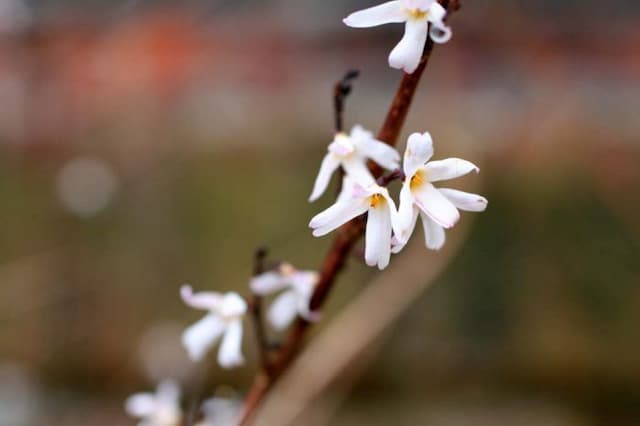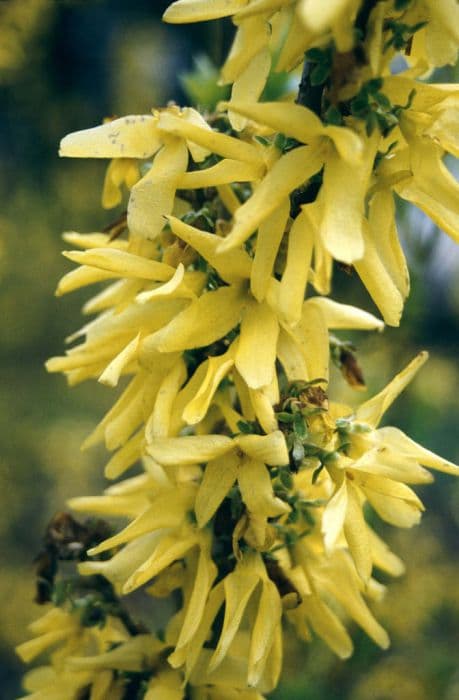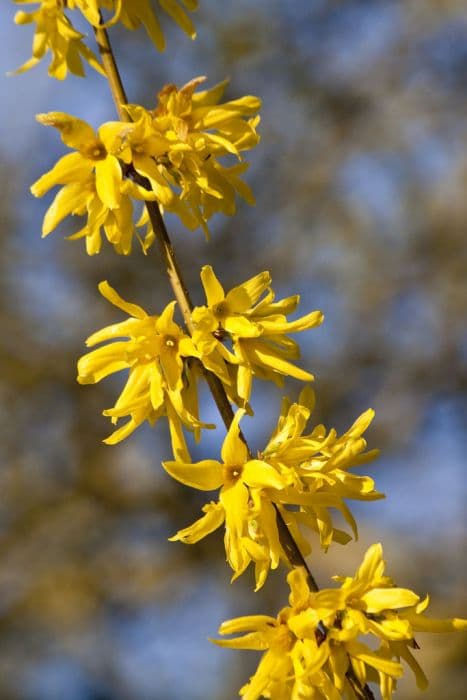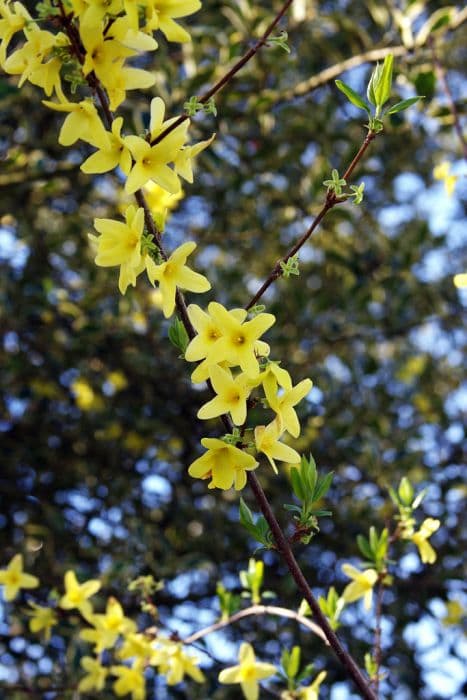Common Lilac Syringa vulgaris 'Madame Lemoine' (d)

ABOUT
Madame Lemoine is a cultivar of the common lilac known for its exceptional beauty. This plant is characterized by its large clusters of double, pure white flowers that exude a sweet and powerful fragrance, which is especially prominent in the late spring. The flower panicles are lush and showy, creating a striking visual display. Its leaves are heart-shaped, with a rich green color that complements the pure white blooms. The plant has a bushy and spreading habit, with multiple stems that produce an abundance of these fragrant flowers. The bark on the branches is typically a grayish-brown, and as the plant matures, it can develop an attractive, somewhat gnarled appearance. The overall impression of Madame Lemoine is one of classic elegance, with its profuse blossoms and refreshing scent making it a favorite among gardeners who wish to add a touch of romantic flair to their landscapes. The beauty of this plant is not only in its stunning floral display but also in its ability to act as a magnet for pollinators, such as butterflies and bees, which are drawn to its nectar-rich flowers.
About this plant
 Names
NamesFamily
Oleaceae
Synonyms
Common Lilac, French Lilac
Common names
Syringa vulgaris 'Madame Lemoine'.
 Toxicity
ToxicityTo humans
Common lilac (Syringa vulgaris) including the variety 'Madame Lemoine' is generally considered to have a low toxicity for humans. Ingesting parts of the plant, particularly in large amounts, can potentially cause stomach upset, including nausea, vomiting, and diarrhea. While severe poisoning is rare, it is advisable to seek medical attention if ingestion occurs and symptoms manifest, especially in children or individuals with sensitive systems.
To pets
Common lilac (Syringa vulgaris), including the variety 'Madame Lemoine', is not considered highly toxic to pets. However, if a pet were to ingest a large amount of the plant, it might experience mild gastrointestinal upset, such as vomiting or diarrhea. As with most plants, it is best to prevent pets from consuming parts of the common lilac to avoid any potential discomfort or more serious symptoms. If a pet does ingest parts of the plant and shows adverse signs, it is wise to consult a veterinarian.
 Characteristics
CharacteristicsLife cycle
Perennials
Foliage type
Deciduous
Color of leaves
Green
Flower color
White
Height
10 feet (3 meters)
Spread
12 feet (3.66 meters)
Plant type
Shrub
Hardiness zones
3
Native area
Europe
Benefits
 General Benefits
General Benefits- Aesthetic Appeal: Lilac's vibrant, abundant flower clusters enhance gardens and landscapes with their beauty.
- Fragrance: Lilac is well known for its intense and pleasant fragrance, which can perfume an entire garden area.
- Pollinator Attraction: The flowers attract butterflies, bees, and other beneficial insects, supporting biodiversity.
- Privacy: When planted in a row, lilacs can form a dense hedge, offering privacy and noise reduction.
- Shade and Cooling: Lilac bushes can provide shade in garden spaces, helping to cool the surrounding area.
- Cultural Significance: Lilacs have a rich history in horticulture and are often associated with springtime and renewal.
 Medical Properties
Medical PropertiesThis plant is not used for medical purposes.
 Air-purifying Qualities
Air-purifying QualitiesThis plant is not specifically known for air purifying qualities.
 Other Uses
Other Uses- Syringa vulgaris 'Madame Lemoine', commonly known as lilac, can be used to make natural dyes for textiles, giving them a range of pastel hues depending on the mordant used.
- The lilac's wood is dense and fine-grained, suitable for making musical instruments such as flutes and panpipes, where a clear tone is desired.
- Lilac branches can be used in the art of miniature tree sculpting known as bonsai, where they are appreciated for their ability to produce a fragrant bloom in a small container.
- In the culinary world, lilac flowers are sometimes used to infuse sugar or make syrups, which can then be utilized in desserts for a floral hint.
- Artists have used lilac blooms as a natural source for botanical illustrations, capturing the intricate details and colors of the flowers.
- The fragrant flowers of the lilac can be added to potpourris, imparting their pleasant scent to mixed dried flowers and botanicals.
- In the craft of soap making, lilac flowers can contribute both a light fragrance and a decorative element to handmade soaps.
- Lilac can be used in homemade fragrances and perfumes, especially in solid perfumes, where its essence is combined with waxes and oils.
- Photographers often utilize the aesthetic appeal of lilac blooms for photo shoots, where the flowers can add a touch of elegance and color to the composition.
- During historical periods, lilac twigs were used to make writing utensils such as pens before the widespread availability of metal nibs.
Interesting Facts
 Feng Shui
Feng ShuiThe common lilac is not used in Feng Shui practice.
 Zodiac Sign Compitability
Zodiac Sign CompitabilityThe common lilac is not used in astrology practice.
 Plant Symbolism
Plant Symbolism- Purity: With its delicate white flowers, 'Madame Lemoine', a cultivar of Lilac, often symbolizes purity and innocence.
- First Emotions of Love: Lilacs in general are associated with the first emotions of love, perhaps due to their gentle appearance and sweet fragrance.
- Renewal: The Lilac typically blooms in spring, a season commonly linked with rebirth and renewal, thus representing fresh starts.
- Youthful Innocence: The youthful heart and innocent joy are often represented by the fresh and lush blooms of the Lilac.
- Memory: Lilacs are also associated with remembrance and nostalgia, often evoking memories of past loves or the innocence of youth.
 Water
WaterThe common lilac, specifically the 'Madame Lemoine' variety, should be watered deeply to encourage root growth, which typically implies using about 1 gallon of water per session for a young plant. Established lilacs require watering once a week during dry spells, but newly planted or young lilacs may need watering twice a week until they are established. The soil should be allowed to dry out slightly between watering sessions. Avoid overhead watering to prevent disease; instead, apply water directly to the base of the plant. During the rainy season or in cooler climates, less frequent watering may be necessary, while more frequent watering may be needed in very hot or windy conditions.
 Light
LightThe common lilac, including the 'Madame Lemoine' variety, thrives in full sunlight for at least 6 hours a day. It prefers a spot where it can receive unfiltered sunlight throughout the day to encourage the best blooming. Avoid placing it in deep shade or overly bright, reflected light, as these conditions can hamper flower production and overall health.
 Temperature
TemperatureThe common lilac, including 'Madame Lemoine', is hardy and adaptable to various temperature conditions, but performs best when the temperature stays within a range of 60 to 75 degrees Fahrenheit. The plant can survive minimum winter temperatures down to -30 degrees Fahrenheit without significant damage. The ideal conditions for the common lilac include a period of winter chill to ensure a vibrant blooming season.
 Pruning
PruningThe common lilac, including 'Madame Lemoine', should be pruned immediately after flowering finishes to shape the plant and remove spent blooms, a process known as deadheading. Pruning helps encourage blooms for the following year, as lilacs flower on old wood. Remove any dead or diseased branches to maintain plant health, and thin out crowded areas to increase air circulation.
 Cleaning
CleaningAs needed
 Soil
SoilThe common lilac (Syringa vulgaris 'Madame Lemoine') grows best in well-draining, fertile soil with a pH of 6.0 to 7.0. A mix with equal parts of loam, peat moss, and well-aged compost or manure will create an ideal growing medium that keeps moisture while also providing good drainage.
 Repotting
RepottingCommon lilacs (Syringa vulgaris 'Madame Lemoine') are typically not repotted as they are large shrubs best suited for outdoor gardens. In the rare case they are container-grown, repotting should occur when the plant is root-bound or every few years to refresh the soil.
 Humidity & Misting
Humidity & MistingCommon lilacs (Syringa vulgaris 'Madame Lemoine') are tolerant of a wide range of humidity levels and do not require high humidity. They thrive in ambient outdoor humidity and do not need additional humidity control when grown in their preferred environment.
 Suitable locations
Suitable locationsIndoor
Provide bright light, cool temperatures, and well-drained soil.
Outdoor
Full sun, well-drained soil, start from a healthy young plant.
Hardiness zone
3-7 USDA
 Life cycle
Life cycleThe common lilac 'Madame Lemoine' begins its life cycle as a seed, which germinates in soil when the conditions of warmth and moisture are right. As a seedling, it establishes a basic root system and sprouts its first leaves, relying on energy reserves from the seed until it can photosynthesize. During the vegetative stage, the lilac experiences rapid growth of foliage and root systems, and annually develops woody stems that can endure for many years. Flower buds form on the lilac in the late summer, but they remain dormant through the fall and winter, breaking dormancy in the spring to bloom with fragrant white double flowers. After pollination, typically by bees, the flowers produce seed capsules which ripen, release seeds, and perpetuate the cycle. Throughout its life, the 'Madame Lemoine' lilac will enter periods of dormancy each winter, resuming active growth with the return of warmer spring temperatures.
 Propogation
PropogationPropogation time
Spring to Summer
Propogation: The Syringa vulgaris 'Madame Lemoine', commonly known as Common Lilac, is typically propagated through softwood cuttings. Softwood cuttings are usually taken in late spring to early summer when the plant's new growth is still tender and green, but the wood is beginning to mature. The most popular method of propagating the Common Lilac is to select healthy shoots and cut sections of about 4 to 6 inches (approximately 10 to 15 centimeters) in length, making sure each cutting has at least a couple of leaf nodes. The lower leaves are removed, and the cut end is often treated with a rooting hormone before being planted in a well-draining potting mix. The cuttings should then be kept moist and in a warm, indirect light until roots have developed, which can take several weeks. Once rooted, the new lilac plants can be transplanted into individual pots or directly into the garden.








